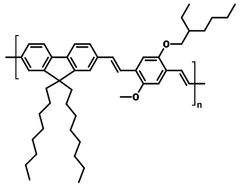PFO-co-MEH-PPV
CAS Number 1383605-56-8
Materials, OFET & OLED Polymer Materials, OPV Polymers, Semiconducting PolymersPFO-co-MEH-PPV, used in highly efficient OLED devices
High quality polymer available for fast, secure dispatch
Specifications | Pricing and Options | MSDS | Literature and Reviews
PFO-co-MEH-PPV, CAS number 1383605-56-8, is a co-polymer consisting of alternating 9,9-dioctylfluorenyl and 2-methoxy-5-(2-ethylhexyloxy)-1,4- phenylenevinylene (MEH-PPV) repeating units in its main backbone structure.
Owing to its capability of harvesting the energy from non-emissive triplet states, PFO-co-MEH-PPV is a reverse intersystem crossing (RISC) polymer which can be used in solution processable, non-doped, highly efficient OLED devices.
PFO-co-MEH-PPV can also be used for polymer lasers with the demonstration of a relaxation oscillation and a picosecond pulse generation.
General Information
| CAS number | 1383605-56-8 |
| Chemical formula | (C48H66O2)n |
| Absorption* | λmax 480 nm (in toluene) |
| Fluorescence | λmax 550 nm (in film) |
| HOMO/LUMO | HOMO = 4,4 eV, LUMO = 2.1 eV [1] |
| Full name |
Poly[{9,9-dioctyl-2,7-divinylene-fluorenylene}-alt-co-{2-methoxy-5-(2-ethylhexyloxy)-1,4-phenyene}] |
| Synonyms | PFOPV, PFPV, PEPV |
| Solubility | Toluene, chloroform or chlorobenzene |
| Classification / Family | PFO and PPV derivatives, Hole transport layer materials; Polymer light-emitting diodes (OLEDs), Green emitter, Organic photovoltaics (OPVs), Polymer lasers, Organic electronics |
* Measurable with an optical spectrometer
Product Details
| Purity | >99% |
| Thermogravimetric Analysis (TGA) | n.a. |
| Appearance | Bright yellow powder/fiber |
Chemical Structure

Pricing
| Batch | Quantity | Price |
|---|---|---|
| M2196A | 100 mg | £260 |
| M2196A | 250 mg | £520 |
| M2196A | 500 mg | £830 |
Batch information
| Batch | Mw | Mn | PDI | Stock info |
|---|---|---|---|---|
| M2196A1 | 302 kDa |
131 kDa | 2.3 | Discontinued |
| M2196A2 | 150 kDa |
Low stock | ||
| M2196A3 | 80 kDa | 35 kDA | 2.3 | In stock |
MSDS Documentation
Literature and Reviews
- The Triplet-Charge Annihilation in Copolymer-Based Organic Light Emitting Diodes: Through “Scattering Channel” or “Dissociation Channel”?, D. Yuan et al., Phys. Chem. Chem. Phys., 17, 27609-27614 (2015); 10.1039/C5CP05016B.
- Relaxation Oscillation with Picosecond Spikes in a Conjugated Polymer Laser, W. Mujamammi et al., Polymers 8, 364 (2016); doi:10.3390/polym8100364
- Advances in Conjugated Polymer Lasers, H. Xia et al, Polymers, 11, 443 2019); doi: 10.3390/polym11030443.

 PFO-co-MEH-PPV MSDS sheet
PFO-co-MEH-PPV MSDS sheet